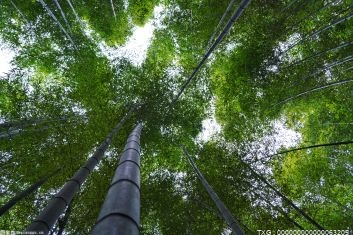TF阅读真题第553篇Lightning
Lightning is a brilliant flash of light produced by an electrical discharge from a storm cloud. The electrical discharge takes place when the attractive tension between a region of negatively charged particles and a region of positively charged particles becomes so great that the charged particles suddenly rush together. The coming together of the oppositely charged particles neutralizes the electrical tension and releases a tremendous amount of energy, which we see as lightning. The separation of positively and negatively charged particles takes place during the development of the storm cloud.
The separation of charged particles that forms in a storm cloud has a sandwich-like structure. Concentrations of positively charged particles develop at the top and bottom of the cloud, but the middle region becomes negatively charged. Recent measurements made in the field together with laboratory simulations offer a promising explanation of how this structure of charged particles forms. What happens is that small (millimeter-to centimeter-size) pellets of ice form in the cold upper regions of the cloud. When these ice pellets fall, some of them strike much smaller ice crystals in the center of the cloud. The temperature at the center of the cloud is about -15℃or lower. At such temperatures, the collision between the ice pellets and the ice crystals causes electrical charges to shift so that the ice pellets acquire a negative charge and the ice crystals become positively charged. Then updraft wind currents carry the light, positively charged ice crystals up to the top of the cloud. The heavier negatively charged ice pellets are left to concentrate in the center. This process explains why the top of the cloud becomes positively charged, while the center becomes negatively charged. The negatively charged region is large: several hundred meters thick and several kilometers in diameter. Below this large, cold, negatively charged region, the cloud is warmer than -15℃, and at these temperatures, collisions between ice crystals and falling ice pellets produce positively charged ice pellets that then populate a small region at the base of the cloud.
Most lightning takes place within a cloud when the charge separation within the cloud collapses. However, as the storm cloud develops, the ground beneath the cloud becomes positively charged and lightning can take place in the form of an electrical discharge between the negative charge of the cloud and the positively charged ground. Lightning that strikes the ground is the most likely to be destructive, so even though it represents only 20 percent of all lightning, it has received a lot of scientific attention.
 (资料图片)
(资料图片)
Using high-speed photography, scientists have determined that there are two steps to the occurrence of lightning from a cloud to the ground. First, a channel, or path, is formed that connects the cloud and the ground. Then a strong current of electrons follows that path from the cloud to the ground, and it is that current that illuminates the channel as the lightning we see.
The formation of the channel is initiated when electrons surge from the cloud base toward the ground. When a stream of these negatively charged electrons comes within 100 meters of the ground it is met by a stream of positively charged particles that comes up from the ground. When the negatively and positively charged streams meet, a complete channel connecting the cloud and the ground is formed. The channel is only a few centimeters in diameter, but that is wide enough for electrons to follow the channel to the ground in the visible form of a flash of lightning. The stream of positive particles that meets the surge of electrons from the cloud often arises from a tall pointed structure such as a metal flagpole or a tower. That is why the subsequent lightning that follows the completed channel often strikes a tall structure.
Once a channel has been formed, it is usually used by several lightning discharges, each of them consisting of a stream of electrons from the cloud meeting a stream of positive particles along the established path. Sometimes, however, a stream of electrons following an established channel is met by a positive stream making a new path up from the ground. The result is a forked lightning that strikes the ground in two places.
【Paragraph 1】Lightning is a brilliant flash of light produced by an electrical discharge from a storm cloud. The electrical discharge takes place when the attractive tension between a region of negatively charged particles and a region of positively charged particles becomes so great that the charged particles suddenly rush together. The coming together of the oppositely charged particles neutralizes the electrical tension and releases atremendousamount of energy, which we see as lightning. The separation of positively and negatively charged particles takes place during the development of the storm cloud.
1. According to paragraph 1, all of the following take place in the development of a flash of lightening EXCEPT
○great tension between two oppositely charged regions
○an increase in negatively charged particles over positively charged particles
○oppositely charged particles coming together
○the release of electrical energy in the form of visible light
【Paragraph 2】The separation of charged particles that forms in a storm cloud has a sandwich-like structure. Concentrations of positively charged particles develop at the top and bottom of the cloud, but the middle region becomes negatively charged. Recent measurements made in the field together with laboratory simulations offer a promising explanation of how this structure of charged particles forms. What happens is that small (millimeter-to centimeter-size) pellets of ice form in the cold upper regions of the cloud. When these ice pellets fall, some of them strike much smaller ice crystals in the center of the cloud. The temperature at the center of the cloud is about -15℃or lower. At such temperatures, the collision between the ice pellets and the ice crystals causes electrical charges to shift so that the ice pelletsacquirea negative charge and the ice crystals become positively charged. Then updraft wind currents carry the light, positively charged ice crystals up to the top of the cloud. The heavier negatively charged ice pellets are left to concentrate in the center. This process explains why the top of the cloud becomes positively charged, while the center becomes negatively charged. The negatively charged region is large: several hundred meters thick and several kilometers in diameter. Below this large, cold, negatively charged region, the cloud is warmer than -15℃, and at these temperatures, collisions between ice crystals and falling ice pellets produce positively charged ice pellets that then populate a small region at the base of the cloud.
2.According to paragraph2, what causes ice crystal to become positively charged?
○Collisions with ice pellets
○Collisions with negatively charged ice crystals at the base of the cloud
○Becoming concentrated in the central region of the cloud
○Forming at a temperature greater than -15℃
3. According to paragraph2, why are positively charged ice pellets produced in the lower part of the cloud?
○Collisions between ice crystals and ice pellets increase in number in the lower part of the cloud.
○The lower part of the cloud is smaller than the region above it.
○More ice pellets than ice crystals reach the lower part of the cloud.
○Temperature in the lower part of the cloud are warmer than -15℃.
4.According to paragraph2, the middle region of a cloud becomes negatively charged due to all of the following EXCEPT
○a shift of electrical charged between ice pellets and ice crystals
○negatively charged ice pellets that remain in the middle
○a temperature of -15℃or less
○the development of a positive charge at the base of the cloud
5.It can be inferred from paragraph 2 that part of the reason that the top of a storm cloud becomes positively charged is that
○the top of the cloud is warmer than the middle of the cloud
○the middle of the cloud is already occupied by positively charged particles
○the negatively charged ice pellets are too heavy to be carried by the updrafts that move ice crystals
○collisions between ice pellets in the top of the cloud produce mainly positively charged particles
【Paragraph 3】Most lightning takes place within a cloud when the charge separation within the cloud collapses. However, as the storm cloud develops, the ground beneath the cloud becomes positively charged and lightning can take place in the form of an electrical discharge between the negative charge of the cloud and the positively charged ground.Lightning that strikes the ground is the most likely to be destructive, so even though it represents only 20 percent of all lightning, it has received a lot of scientific attention.
6.The author remarks that“Lightning that strikes the ground is the most likely to be destructive”in order to explain why
○this form of lightning has been investigated so much
○this form of lightning is not as common as lightning within a cloud
○scientific understanding of this form of lightning is important
○the buildup of positive charge on the ground beneath a storm cloud can have serious consequences
【Paragraph 4】Using high-speed photography, scientists have determined that there are two steps to the occurrence of lightning from a cloud to the ground. First, a channel, or path, is formed that connects the cloud and the ground. Then a strong current of electrons follows that path from the cloud to the ground, and it is that current thatilluminatesthe channel as the lightning we see.
【Paragraph 5】The formation of the channel isinitiatedwhen electrons surge from the cloud base toward the ground. When a stream of these negatively charged electrons comes within 100 meters of the ground it is met by a stream of positively charged particles that comes up from the ground. When the negatively and positively charged streams meet, a complete channel connecting the cloud and the ground is formed. The channel is only a few centimeters in diameter, but that is wide enough for electrons to follow the channel to the ground in the visible form of a flash of lightning. The stream of positive particles that meets the surge of electrons from the cloud often arises from a tall pointed structure such as a metal flagpole or a tower. That is why the subsequent lightning that follows the completed channel often strikes a tall structure.
7. According to paragraph5, which of the following is true of the stream of charged particles from the ground?
○It prevents streams of electrons from the cloud from striking the ground.
○It completes a channel that connects the storm cloud with the ground.
○It produces a stream of electrons from the cloud.
○It widens the path made by the initial stream of electrons from the cloud.
8.Which of the following claims about lightning strikes can be inferred from paragraph 5?
○During a lightning strike the diameter of the channel the electrons follow is considerably enlarged beyond a few centimeters.
○A building is unlikely to be hit by lightning unless it is at least 100 meters tall.
○A building is hit by a lightning strike because the building itself has first determined the path the lightening then takes to it.
○The light of a lightning strike first appears at the point where the streams of negative and positive particles meet.
The formation of the channel is initiated when electrons surge from the cloud base toward the ground. When a stream of these negatively charged electrons comes within 100 meters of the ground it is met by a stream of positively charged particles that comes up from the ground. When the negatively and positively charged streams meet, a complete channel connecting the cloud and the ground is formed. The channel is only a few centimeters in diameter, but that is wide enough for electrons to follow the channel to the ground in the visible form of a flash of lightning. The stream of positive particles that meets the surge of electrons from the cloud often arises from a tall pointed structure such as a metal flagpole or a tower.
That is why the subsequent lightning that follows the completed channel often strikes a tall structure.■
Once a channel has been formed, it is usually used by several lightning discharges, each of them consisting of a stream of electrons from the cloud meeting a stream of positive particles along the established path.■Sometimes, however, a stream of electrons following an established channel is met by a positive stream making a new path up from the ground.■The result is a forked lightning that strikes the ground in two places.■
9.Look at the four squares [■] that indicate where the following sentence could be added to the passage.
The descending stream of electrons divides at the point where the new positive-stream channel intersects the established path.
Where would the sentence best fit?
10.【Directions】An introductory sentence for a brief summary of the passage is provided below. Complete the summary by selecting the THERR answer choices that express the most important ideas in the passage. Some sentences do not belong in the summary because they express ideas that are not presented in the passage or are minor ideas in the passage. This question is worth 2 points.
Lightning takes place when a separation of a positive and negative electrical particles that develops in a storm could suddenly collapses.
●
●
●
○A storm cloud first develops a positively charged layer at the top, then a negatively charged middle layer, and finally, a positively charged layer at the bottom.
○A separation of oppositely charged particles in clouds develops from collisions of falling ice pellets with ice crystals, from updrafts, and from temperature variations.
○Lightning from cloud to ground follows a channel that forms when a stream of electrons moving down meets a stream of positive particles coming up from the ground.
○Field studies, laboratory simulations, and high-speed photography have all been used to investigate the way charge separations develop in clouds.
○Lightning from a cloud to the ground is more likely to be destructive than is lightning that takes place within a cloud.
○Once a channel has been formed, it is usually used by several successive electrical discharges that illuminate the channel as flashes of lightning.
标签:





